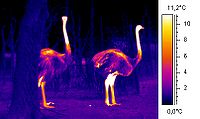
Photo from wikipedia
Background In psoriasis treatment, not all body regions improve simultaneously after clinical interventions. Objective This study was aimed at evaluating clinical responses across body regions, which may differentially influence patient… Click to show full abstract
Background In psoriasis treatment, not all body regions improve simultaneously after clinical interventions. Objective This study was aimed at evaluating clinical responses across body regions, which may differentially influence patient treatment plans. Methods This prospective, observational, and multi-center study was conducted in Koreans who adhered to ustekinumab treatment based on criteria per local label and reimbursement guidelines. A total of 581 were included in this analysis. Results The mean (±standard deviation) psoriasis area severity index (PASI) score at baseline, age, disease duration, and body surface area (%) were 18.9±9.69, 44.2±13.29 years, 11.3±9.65 years, and 27.8±17.83, respectively. Across the head and neck, upper extremities, trunk, and lower extremities, the correlation between the PASI sub-scores for the upper and lower extremities was the highest (r=0.680). The mean PASI sub-score for the lower extremities was the highest at baseline. PASI90 and PASI100 scores were the highest for the head and neck region, indicating the highest response rates, while those for the lower extremities were consistently low at all visits. Conclusion We found differences in regional ustekinumab responses, with the lower extremities being the most difficult to treat. These findings should be considered in psoriasis treatment.
Journal Title: Annals of Dermatology
Year Published: 2022
Link to full text (if available)
Share on Social Media: Sign Up to like & get
recommendations!